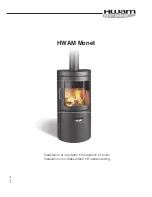
46
Fill water
!
Please note
Unsuitable fill water increases the level of
deposits and corrosion, and may lead to system
damage.
■
Flush the heating system thoroughly before
filling.
■
Only fill with water of potable quality.
■
Special antifreeze suitable for heating systems
can be added to the fill water. The antifreeze
manufacturer must verify its suitability.
■
Fill and top-up water with a water hardness in
excess of the following values must be soft-
ened, e.g. with a small softening system for
heating water.
Total permissible hardness of the fill and top-up water
Total heating output
Specific system volume
kW
< 20 l/kW
≥
20 l/kW to < 50 l/kW
≥
50 l/kW
≤
50
≤
3.0 mol/m
3
(16.8 °dH)
≤
2.0 mol/m
3
(11.2 °dH)
< 0.02 mol/m
3
(0.11 °dH)
50 to 200
≤
2.0 mol/m
3
(11.2 °dH)
≤
1.5 mol/m
3
(8.4 °dH)
< 0.02 mol/m
3
(0.11 °dH)
Fig. 35
1.
Check the pre-charge pressure of the expansion
vessel.
If the pre-charge pressure is lower than the static
system pressure, top up with nitrogen until the pre-
charge pressure is 0.1 to 0.2 bar (10 to 20 kPa)
higher than the static system pressure.
If the pre-charge pressure is too high, adjust it
accordingly.
2.
Open the non-return valves.
3.
Fill the heating system with water. Then bleed until
the charge pressure is 0.1 to 0.2 bar (10 to 20 kPa)
higher than the pre-charge pressure of the expan-
sion vessel.
Permissible operating pressure: 3 bar (0.3 MPa)
Test pressure: 4 bar (0.4 MPa)
4.
Mark the charge pressure at pressure gauge
A
.
5.
Reset the non-return valves to their operating posi-
tion.
Checking all connections on the heating water side for leaks
Checking safety equipment
Commissioning, inspection, maintenance
Filling the heating system
5679249
















































